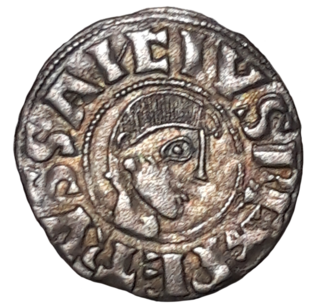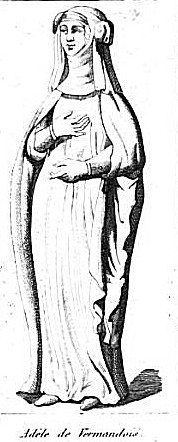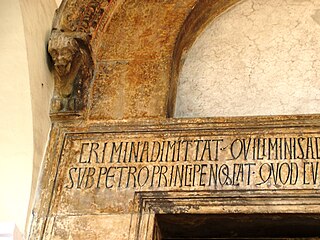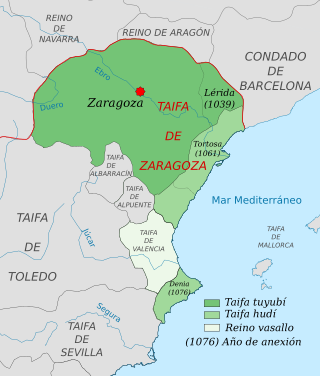
Peter I was King of Aragon and also Pamplona from 1094 until his death in 1104. Peter was the eldest son of Sancho Ramírez, from whom he inherited the crowns of Aragon and Pamplona, and Isabella of Urgell. He was named in honour of Saint Peter, because of his father's special devotion to the Holy See, to which he had made his kingdom a vassal. Peter continued his father's close alliance with the Church and pursued his military thrust south against bordering Al-Andalus taifas with great success, allying with Rodrigo Díaz de Vivar, known as El Cid, the ruler of Valencia, against the Almoravids. According to the medieval Annales Compostellani Peter was "expert in war and daring in initiative", and one modern historian has remarked that "his grasp of the possibilities inherent in the age seems to have been faultless."
Robert de Beaumont, 1st Earl of Leicester, Count of Meulan, also known as Robert of Meulan, was a powerful Norman nobleman, one of the very few proven Companions of William the Conqueror during the Norman Conquest of England in 1066, and was revered as one of the wisest men of his age. Chroniclers spoke highly of his eloquence and his learning, and three kings of England valued his counsel. He was granted immense land-holdings in England by William the Conqueror and by Henry I and was created Earl of Leicester.

Roger Borsa was the Norman Duke of Apulia and Calabria and effective ruler of southern Italy from 1085 until his death.

Guaimar IV was Prince of Salerno (1027–1052), Duke of Amalfi (1039–1052), Duke of Gaeta (1040–1041), and Prince of Capua (1038–1047) in Southern Italy over the period from 1027 to 1052. He was an important figure in the final phase of Byzantine authority in the Mezzogiorno and the commencement of Norman power. He was, according to Amatus of Montecassino, "more courageous than his father, more generous and more courteous; indeed he possessed all the qualities a layman should have—except that he took an excessive delight in women."
Geoffrey the Elder was an Italo-Norman nobleman. A nephew of Robert Guiscard through one of his sisters, he was the count of Conversano from 1072 and the lord of Brindisi and Nardò from 1070, until his death.
Robert I was an Italo-Norman nobleman, the eldest son of Geoffrey of Hauteville, one of the elder sons of Tancred of Hauteville. He was the first count of Loritello in 1061.
Henry was the Count of Monte Sant'Angelo, with his seat at Foggia, from November 1081.

The Norman conquest of southern Italy lasted from 999 to 1139, involving many battles and independent conquerors.
The County of Monte Sant'Angelo or Gargano was a large Norman county in southern Italy, covering the Gargano Peninsula and much of the later Province of Foggia. Its comital seat was Monte Sant'Angelo.
Gualganus, surnamed Ridel, was the third and last Count of Pontecorvo and Duke of Gaeta of the Norman Ridel family from about 1091 until about 1103. He was a son and successor of Duke Raynald Ridel, but his rule in Gaeta was not unopposed.
Events from the 1100s in England.
Theodoric I was a Count of Montbéliard, Count of Bar and lord of Mousson and Count of Verdun. He was the son of Louis, Count of Montbéliard, and Sophie, Countess of Bar and Lady of Mousson.

William the Simple was Count of Blois and Count of Chartres from 1102 to 1107, and jure uxoris Count of Sully.

Adelaide of Vermandois was suo jure Countess of Vermandois and Valois from 1080 to 1120.
Ranulf I was the count of Caiazzo in the Principality of Capua from about 1078. He also brought the formerly Lombard counties of Alife, Telese and Sant'Agata dei Goti and the castles of Airola and Tocco Caudio under his control, dominating the region between Capua and Benevento. He passed this territorial lordship on intact to his heirs, and it remained in their possession until the death of his grandson and namesake, Ranulf II, in 1139.

Robert was a south Italian nobleman who ruled the counties of Airola, Alife, Caiazzo, Sant'Agata and Telese from 1088 until his death. He was the regent of Capua in 1090–93, and was effectively independent of any lord after 1105. He was a major patron of churches and abbeys, and also commissioned several books.
Events during the year 1102 in Italy.

The Taifa of Lérida was a factional kingdom (ṭāʾifa) in Muslim Iberia between 1039/1046 and 1102/1110. Based on the city of Lérida, the ṭāʾifa was not an independent state throughout this period but was sometimes a part of the larger ṭāʾifa of Zaragoza ruled by a governor (wālī).

The Monte Astu massif is a chain of mountains in the northeast of the island of Corsica, France. It takes its name from Monte Astu, the highest peak.